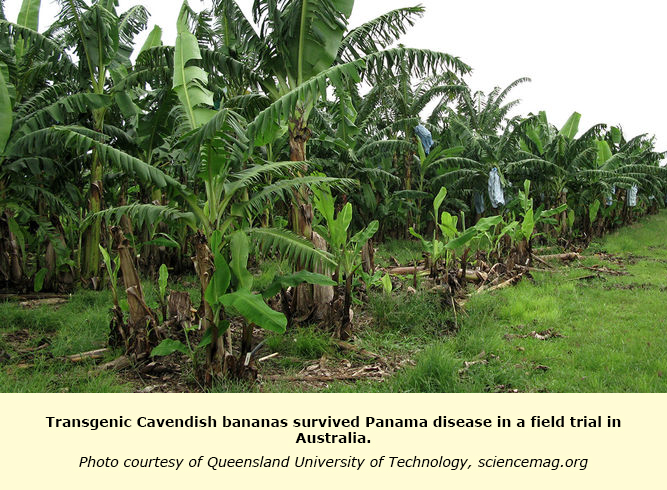A field trial in Australia has shown that genetically modified banana trees can resist the deadly fungus that causes Panama disease, which has devastated banana crops in Asia, Africa, and Australia and is a major threat for banana growers in the Americas. The transgenic plants might reach some farmers in as few as 5 years, but it’s unclear whether consumers will bite. The work may encourage plant breeders using traditional techniques to create resistant varieties.

Bananas, one of the world’s most popular fruits, are a staple for more than 400 million people and a huge export business. In the 1950s, a soil-dwelling fungus destroyed Latin American crops of the most popular variety at the time, Gros Michel; it was replaced by a resistant variety, Cavendish, which now makes up more than 40% of harvests worldwide. In the 1990s, the Cavendish’s own nemesis surfaced in Southeast Asia: a related fungus called Fusarium wilt tropical race 4 (TR4).
Fungicides can’t control TR4; disinfecting boots and farm tools helps, but not enough. TR4 was detected in the Middle East in 2012 and appeared in Mozambique a year later. It has reached all banana-growing regions of China and was confirmed in Laos and Vietnam this year. Only the Americas have been spared so far. “This is an extremely important crop with major problems,” says study co-author Gert Kema, a plant pathologist and banana breeder at Wageningen University & Research in the Netherlands.
Biotechnologist James Dale and colleagues at Queensland University of Technology in Brisbane, Australia, cloned a resistance gene named RGA2 from a type of wild banana that’s impervious to TR4 and inserted it into the Cavendish, creating six lines with varying numbers of RGA2 copies. They also created Cavendish lines with Ced9, a nematode gene known to confer resistance to many kinds of plant-killing fungi.
In 2012, the researchers planted their transgenic bananas, along with unmodified controls, at a farm about 40 kilometers southeast of Darwin, Australia, where Panama disease arrived 20 years ago. To be doubly sure the plants would be exposed to TR4, the researchers buried infected material near each plant. In the 3-year trial, 67% to 100% of control banana plants died or had yellow, wilting leaves and rotting trunks. But several transformed lines did well, with about 80% of plants remaining symptomless, and two lines—one outfitted with RGA2, the other with Ced9—were completely invulnerable, the team reported online 14 November in Nature Communications. The resistance genes did not reduce the size of banana bunches.
“This resistance is outstanding and a cause for optimism,” says Randy Ploetz, a plant pathologist at the University of Florida in Homestead who was not involved in the study. But Agustin Molina, a plant pathologist affiliated with Bioversity International, a nonprofit agricultural biodiversity organization, who is based in Los Baños, Philippines, is skeptical about the appeal of transgenic bananas: “The problem is that current markets are not receptive.”
There are other options, he says. Small-scale farmers often grow a range of non-Cavendish banana varieties for local consumption that can tolerate or resist TR4. Many larger farms in the Philippines, where TR4 arrived in 2000, have learned to prevent its spread and have begun planting disease-tolerant varieties of Cavendish. Though these may be of lower quality and can take longer to mature, “Our banana industry is still growing,” Molina says.
Miguel Dita, a plant pathologist with the Brazilian Agricultural Research Corporation in Jaguariúna, says it’s important to look for other replacements, including varieties other than Cavendish. “There are many opportunities to diversify the industry with different bananas, including more nutritious and better-tasting ones.”
Dale and his colleagues are pressing ahead with a second field trial, including new lines. “We’ll tick all the boxes on quality and prepare for deregulation,” he says. “We now have at least one solution for continuing Cavendish as the world’s most important banana.”
Written by Erik Stokstad
Source: Science
